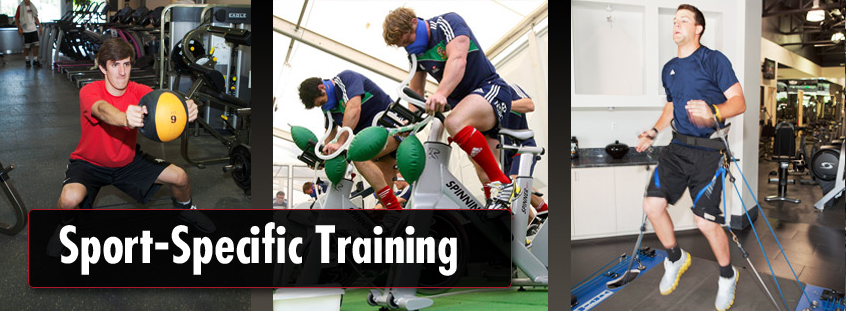Athletes of all types rely on strength and agility in specific areas of their body in order to excel in their sport and perform at their optimum level. Sport-specific training programs are carefully crafted to focus on conditioning the body and mind to excel through the unique demands for endurance, speed, agility, balance and recovery required by each sport as well as minimize injury.
The sports landscape is becoming more and more competitive. Kids are starting to hone their natural athletic abilities younger and younger and sport-specific training can help athletes of all ages, as it’s commonly comprised of three classifications of training that start with building core strength and agility before moving into more specific movements that mimic the athlete’s respective sport:
General strength exercises develop general muscle strength and include movements like squats, front squats, overhead squats and deadlifts among many, many others.
Special strength exercises attempt to convert general strength to power, but are still strength oriented. Most explosive lifts and movements fit into this category and include olympic lifts, jump squats, heavy sled towing and various kettlebell swings and exercises.
Specific strength exercises are designed to provide power improvements in a way that is very specific to the required technique of the athlete. Exercises may include unloaded and lightly loaded plyometric exercises and sprint drills. The most specific strength exercise for any given movement is the actual movement skill itself and it is in this category where you will focus on those movements repetitively.
An integral part of each of the above strength classifications are drills that help establish quickness, speed and agility for quick stops, change of direction and acceleration:
Sprint training such as suicides, resistance sprinting (using a resistance chute) and cone drills develop explosive speed
Agility work often includes an agility ladder (with resistance bands) to develop quick feet
Bodies by Mahmood features the VertiMax training system at their downtown training facility. The VertiMax system uses a series of pulleys and strategically placed straps to add resistance and is shown to improve explosiveness, speed, and vertical jump. Technology like this combined with proven training methods and drills comprise a sports specific training program.
By committing to a sport-specific training program, athletes are able to practice muscle memory drills and conditioning formats that are designed to improve their overall performance in their sport while maximizing their response to and recovery from the physical demands of their sport, which are vastly different from sport to sport. Research conducted on golfers showed the amount of force traveling through the spine during a vigorous swing is an average of eight times their body weight. With that amount of force traveling down the spine, it’s imperative that a golf program is designed to maintain range of motion while simultaneously improving strength and stability through the core and spine. Football on the other hand is a collision sport and requires several layers of training for both skill and power positions that includes a series of weight lifting, agility drills, plyometrics and nutrition.
A truly sport-specific exercise must:
Duplicate the exact movement witnessed in certain actions of sport
Involve the same type of muscular contraction used in the skill execution
Develop strength and flexibility in the same range of motion as the actual skill
An athlete will benefit tremendously from this type of training, most likely seeing dramatic improvements in their level of fitness and strength. Benefits of sport-specific training include:
Increased speed
Increased agility
Improved conditioning
Injury prevention
Gaining a competitive edge
Increased acceleration and power
Improved balance and body awareness
Increased flexibility
Increased strength
Improved endurance and ability to quickly recover from training and competition
Sport-specific training isn’t just for extreme athletes. The more recreational or “weekend warrior” types can benefit from training routines designed for their respective sport. Runners, cyclists, Ironmen and recreational team players can train their bodies to endure physical stress for longer periods of time and recover faster, allowing them to set and reach successive goals instead of plateauing.


